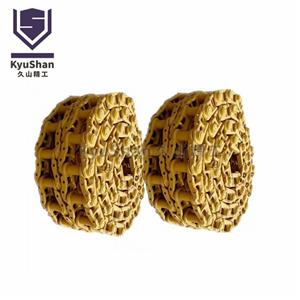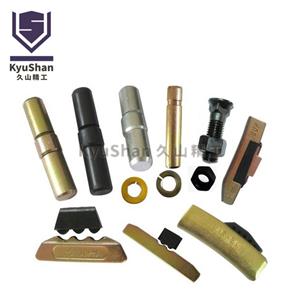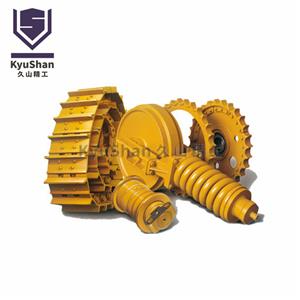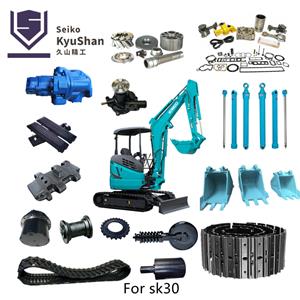Teach You How To Improve The Service Life Of Excavator Rollers
The structure of the excavator roller is mainly divided into the wheel body, the roller shaft, the shaft sleeve, the sealing ring, and the end cover. Then there will be the phenomenon of oil leakage within a few days after installation. It is recommended that every time you buy a product, you should carefully check its structure, brand, price and make a record of which one you bought it from. If it is not easy to use next time Don't make repeated purchases. You can also talk to the supplier about quality issues when purchasing, tell him your requirements for the product, and how to solve the problem of oil leakage in a few days.
The crawler excavator travel mechanism carries the full weight of the excavator and is responsible for the driving function of the excavator. The main damage form is wear, which is concentrated in the following contact parts: the outer surface of the drive wheel teeth and the track pin sleeve: the idler wheel and the track link raceway surface; the roller and the track track link raceway surface; carrier roller and track link raceway surface; track pin and pin sleeve contact surface; track shoe and ground, etc.
1. Wear of the track
In the running mechanism of the dry track (as opposed to the lubricated track and the sealed track), the track is not lubricated, which causes wear between the track pin and the pin sleeve due to the relative movement during the working process. Wear between pins and pin sleeves in the track is unavoidable and normal, but this wear will lengthen the pitch of the track and make the track too large. If this wear condition continues, the track will move sideways, which will cause the wear of the idler wheel, roller, carrier wheel, drive gear teeth and other components, and also aggravate the wear of the track pin and sleeve.
The wear of the track is also manifested in the reduction of the track barb height due to the contact between the track shoe and the ground, and the track link height caused by the contact between the track surface of the track link track and the guide wheel, carrier wheel and roller. of reduction. Severe wear of the track shoes will result in the loss of traction force of the excavator.
2. Wear of idler pulley
The wear of the guide wheel is caused by the contact with the raceway surface of the chain link, and the wear of the convex width of the guide wheel body is caused by the contact with the side surface of the chain link. It is manifested as: the reduction of the convex width of the guide wheel body; the reduction of the diameter of the raceway surface of the guide wheel body; the reduction of the diameter of the guide wheel body
3. Wear of carrier rollers
Wear of the carrier rollers is caused by contacting the raceway surfaces of the chain links. The manifestations are: the reduction of the flange width of the carrier wheel; the reduction of the outer diameter of the track surface of the carrier wheel; the reduction of the outer diameter of the carrier wheel flange.
4. Wear of the rollers
The wear of the track roller is the same as the wear of the carrier wheel and the guide wheel, which is also caused by the contact with the raceway surface of the chain link. The specific manifestations are: the reduction of the diameter of the outer flange; the reduction of the diameter of the raceway surface; the reduction of the diameter of the bilateral inner flange; the reduction of the width of the bilateral inner flange; the reduction of the width of the outer flange.
For the wear of the crawler traveling mechanism, the following measures can be taken:
(1) If the walking mechanism of the excavator is obviously worn in the early stage, the operation should be stopped immediately, and the coincidence of the center of the guide wheel, the supporting sprocket, the supporting wheel, the driving wheel and the longitudinal center line of the walking frame should be checked;
(2) In order to prolong the service life, the front and rear rollers can be exchanged, but the original position of the single and bilateral rollers on the walking frame must be kept unchanged;
(3) After the parts of the traveling mechanism are worn to the limit of use, the guide wheels, supporting sprockets, rollers, driving wheel teeth, thorns, and chain rails can be repaired or replaced by surfacing welding;
(4) For the situation that the pitch of the track chain track becomes longer due to wear, the reversal chain track link can be used to remedy the situation or a new chain track link can be replaced.
The track roller is used to support the weight of the tractor, while rolling on the track (rail link) or track shoe surface of the track, and it is also used to limit the track to prevent lateral slippage. The rollers force the track to slip on the ground when the tractor turns. Rollers are often exposed to mud, water and dust and are subject to strong impacts, so they are required to have reliable sealing and wear-resistant rims. If there is oil leakage in the roller, how should it be replaced in time, and how can we check for oil leakage?
1. During the installation process, it should be strictly inspected according to the technical requirements of the parts, keep it clean, and prevent impurities from entering the installation surface. Especially on the sealing end face of the sealing ring, even tiny dust particles will damage the sealing and cause oil leakage.
2. The sealing sleeve and the sealing rubber ring need to be replaced with new ones if they are aging, deformed, scarred or broken.
3. The spring should be replaced when its elastic force is insufficient, and the uneven end surface can be ground. When the pressure ring is warped, it should be repaired and leveled, and sharp edges should be removed.
4. The large and small sealing rings are not in strict contact and can be re-ground to make them have a uniform and continuous grinding ring. Do not hit the ring end face and disturb the mate ring. The thickness of the ring should be the same, otherwise it must be replaced.
5. The thickness of the rubber ring is not enough, it is allowed to wrap the asbestos rope to make it reach a tightness of 0.15~0.20 kg per square centimeter.
6. The wheel axle is bent, out of circle or the neck is worn, the wheel hub of the roller and the wear of the matching belt of the sealing shell must be repaired.
7. When the plane of the bearing and the sealing ring is worn, a 2-4 mm thick oil-resistant rubber ring can be placed between the sealing sleeve and the end face of the hub according to the degree of wear. When installed, the gland assembly should rotate freely on the hub. In addition, a washer with an outer diameter of 100 mm, an inner diameter of 85 mm and a thickness of 1.5 mm can be placed between the bearing outer ring and the support shoulder of the seal housing to compensate for the bearing wear. When the height of the sealing sleeve is less than 32 mm and the width of the bearing is less than 41 mm, it should be replaced with new products.
8. The paper pads on the rollers should be kept intact and of suitable thickness.
The above is about the method of inspection and elimination of oil leakage of excavator rollers. I hope that all excavator masters can refer to and learn from their own experience and experience, and regularly maintain and inspect the excavator to prolong its service life.




